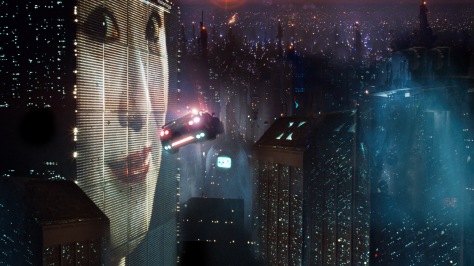Any film dealing with the topic of artificial intelligence must also take on the heady topics of consciousness and self awareness. I wish I could remember the name of the researcher, but she was quoted in a research journal as saying that, no matter how much we learn about the physiological workings of the brain, we will still be no closer to explaining the subjective experience we call consciousness. Still, be it neuroscience or science fiction, we find the underlying concept that the soul is merely physical: patterns of electrochemical activity traveling along organic, neural circuits. If this assumption is correct, then truly artificial intelligence can be created in the laboratory. Then again, the creation of artificial intelligence does not automatically preclude the existence of a nonmaterial soul in human beings.
Concentrating on a neo-noir approach and grotesquely distopian imagery, Blade Runner (1982 Warner Brothers, directed by Ridley Scott) touches on this theme but pushes it more into the background. Owing more than a little to this visual approach, it is considered as one of the best science fiction movies of all time. There is a poignant emphasis on the desire of the replicants to continue living, and a sense of tragedy therefore underlies the story.
Starring Harrison Ford, an effectively villainous yet nuanced Rutger Hauer, Daryl Hannah, and an evocative Sean Young, Blade Runner was loosely based on Do Androids Dream of Electric Sheep?, written by Philip K. Dick.
The movie which more satisfyingly explores my stated theme is Ex Machina (2014 Universal Pictures, written and directed by Alex Garland).
There are mind bending discussions with several layers of deception. These serve as information dumps which advance the plot without dragging it down. Rather, they heighten the suspense.
But the two men played by Oscar Isaac and Domhnall Gleeson revolve around the androids chillingly played by Alicia Vikander and Sonoya Mizuno.
Two elements that really resonated with me were the psychological study of the android under the auspices of a type of Turing test. This involved the transformation of a machine into a woman within the perception of “her” interrogator.
I was intrigued by the concept behind the physical nature of the artificial brains of the androids. That particular visual made my mind race, and the accompanying explanation of forming and removing connections (as our own brains are constantly doing with synapses between neurons) made proper but not tedious reference to certain findings of neuroscientific research.
As a warning for those who might object, there is some nudity which I felt was not essential to the plot, and there is a bit of violence, as well. This is dark, disturbing stuff, but it is extremely well made. I think it appropriate to give credit where credit is due.











































